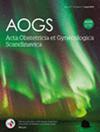A comparison of the treatment outcome of Asherman's syndrome which developed within and outside the puerperal period: A matched cohort study
Abstract
Introduction
The outcome following hysteroscopy adhesiolysis of Asherman’s syndrome in the puerperal period who appeared to do less well than the participants who developed the syndrome unrelated to child birth. As there is no literature to support or refute the observation, we decided to conduct a retrospective cohort study to compare the outcome of hysteroscopic adhesiolysis in women who developed Asherman's syndrome within or outside the puerperal period.
Material and Methods
This retrospective cohort study aimed to compare the outcome of hysteroscopic adhesiolysis in women who developed Asherman's syndrome within the puerperal period and women who developed the Asherman's syndrome outside the puerperal period. Fifty-one women suffered from Asherman's syndrome in the puerperal period and 153 women suffered from Asherman's syndrome which developed outside the puerperal period. Second-look and third-look hysteroscopy were performed 4 and 8 weeks after hysteroscopic adhesiolysis.
Results
The primary outcome measures were the postoperative adhesion reformation rate and the magnitude of reduction in American Fertility Society score as assessed at second-look hysteroscopy. The secondary outcome measure was the change in menstrual pattern at 3 months after surgery. The adhesion reformation rate in puerperal group was 86.3%, which was significantly (p < 0.05) higher than that of 38.6% in the non-puerperal (non-puerperal) group. The median reduction in the adhesion score was 4.5 (4–6) in the puerperal group, which was significantly (p < 0.001) lower than the median reduction 7 (6–8) of the non-puerperal group. In the puerperal group, the reduction rate of American Fertility Society score after hysteroscopic adhesiolysis was 42.4%, which was significantly lower than that of 72.6% in the non-puerperal group. In the puerperal group, only 56.9% of women experienced improvement in menstruation defined as subjective increase in menstrual flow after surgery, which was significantly lower than that of 83.7% observed in the non-puerperal group.
Conclusions
Following hysteroscopic adhesiolysis, the outcome of Asherman's syndrome in women who developed the condition in the puerperal period was worse than those who developed the condition outside the puerperal period. Strategies to minimize damage and promote regeneration of the endometrium in the puerperal period in women at risk of developing intrauterine adhesions should be promoted.


 求助内容:
求助内容: 应助结果提醒方式:
应助结果提醒方式:


